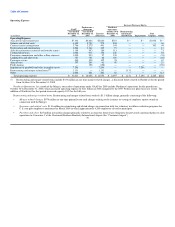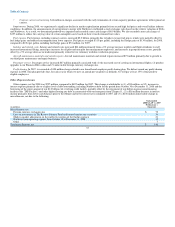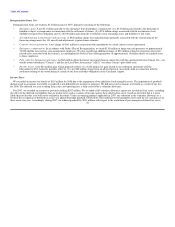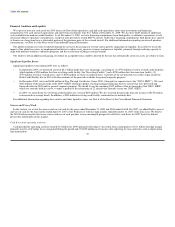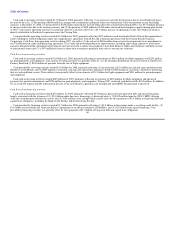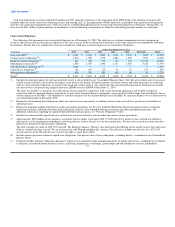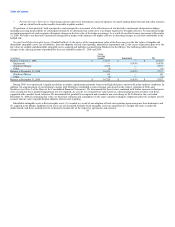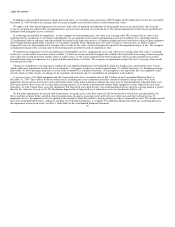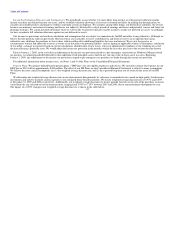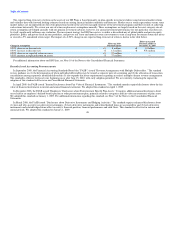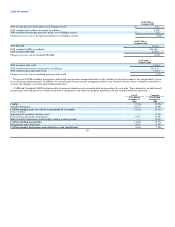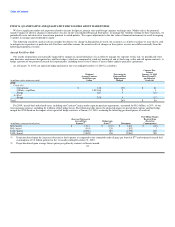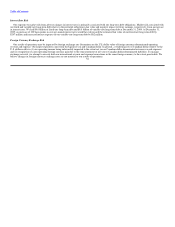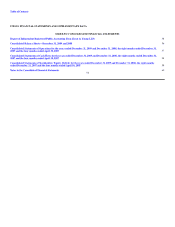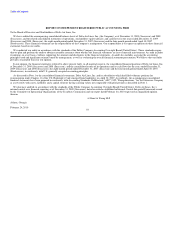Delta Airlines 2009 Annual Report Download - page 51
Download and view the complete annual report
Please find page 51 of the 2009 Delta Airlines annual report below. You can navigate through the pages in the report by either clicking on the pages listed below, or by using the keyword search tool below to find specific information within the annual report.
Table of Contents
In addition to the goodwill impairment charge discussed above, we recorded a non-cash charge of $357 million ($238 million after tax) for the year ended
December 31, 2008 to reduce the carrying value of certain intangible assets based on their revised estimated fair values.
We apply a fair value-based impairment test to the net book value of goodwill and indefinite-lived intangible assets on an annual basis and, if certain
events or circumstances indicate that an impairment loss may have been incurred, on an interim basis. The annual impairment test date for our goodwill and
indefinite-lived intangible assets is October 1.
In evaluating our goodwill for impairment, we first compare our one reporting unit's fair value to its carrying value. We estimate the fair value of our
reporting unit by considering (1) our market capitalization, (2) any premium to our market capitalization an investor would pay for a controlling interest,
(3) the potential value of synergies and other benefits that could result from such interest, (4) market multiple and recent transaction values of peer companies
and (5) projected discounted future cash flows, if reasonably estimable. If the reporting unit's fair value exceeds its carrying value, no further testing is
required. If, however, the reporting unit's carrying value exceeds its fair value, we then determine the amount of the impairment charge, if any. We recognize
an impairment charge if the carrying value of the reporting unit's goodwill exceeds its implied fair value.
We perform the impairment test for our indefinite-lived intangible assets by comparing the asset's fair value to its carrying value. Fair value is estimated
based on (1) recent market transactions where available, (2) the lease savings method for airport slots (which reflects potential lease savings from owning the
slots rather than leasing them from another airline at market rates), (3) the royalty method for the Delta tradename (which assumes hypothetical royalties
generated from using our tradename) or (4) projected discounted future cash flows. We recognize an impairment charge if the asset's carrying value exceeds
its estimated fair value.
Changes in assumptions or circumstances could result in an additional impairment in the period in which the change occurs and in future years. Factors
which could cause impairment include, but are not limited to, (1) negative trends in our market capitalization, (2) volatile fuel prices, (3) declining passenger
mile yields, (4) lower passenger demand as a result of the weakened U.S. and global economy, (5) interruption to our operations due to an employee strike,
terrorist attack, or other reasons, (6) changes to the regulatory environment and (7) consolidation of competitors in the industry.
Long-Lived Assets. Our flight equipment and other long-lived assets have a recorded value of $20.4 billion on our Consolidated Balance Sheet at
December 31, 2009. This value is based on various factors, including the assets' estimated useful lives and their estimated salvage values. We record
impairment losses on long-lived assets used in operations when events and circumstances indicate the assets may be impaired and the estimated future cash
flows generated by those assets are less than their carrying amounts. If we decide to permanently remove flight equipment or other long-lived assets from
operations, we will evaluate those assets for impairment. For long-lived assets held for sale, we record impairment losses when the carrying amount is greater
than the fair value less the cost to sell. We discontinue depreciation of long-lived assets when these assets are classified as held for sale.
To determine impairments for aircraft used in operations, we group assets at the fleet-type level (the lowest level for which there are identifiable cash
flows) and then estimate future cash flows based on projections of capacity, passenger mile yield, fuel costs, labor costs and other relevant factors. If
impairment occurs, the impairment loss recognized is the amount by which the aircraft's carrying amount exceeds its estimated fair value. We estimate aircraft
fair values using published sources, appraisals and bids received from third parties, as available. For additional information about our accounting policy for
the impairment of long-lived assets, see Note 1 of the Notes to the Consolidated Financial Statements.
46


